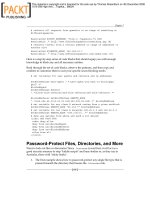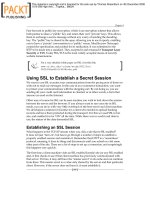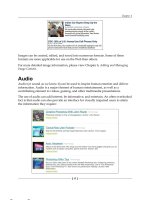Multimedia cho Joomla part 17 docx
Bạn đang xem bản rút gọn của tài liệu. Xem và tải ngay bản đầy đủ của tài liệu tại đây (2.04 MB, 10 trang )
Chapter 6
[ 167 ]
The Global Conguration also contains other media settings such as Max File upload
size, which may need to be taken into consideration when uploading videos.
Once your
videos directory has been created, simply use the le upload feature of
the Media Manager to upload your le into the selected directory.
Editors
One of the most frustrating things with WYSIWYG editors is that they strip out or
adjust your nicely formatted code. Some are worse than others at performing this
role, but it will be in your interest to turn off your WYSIWYG editor when entering
anything but simple HTML custom code into your Joomla! Articles.
Although, I have just recommended that you turn your editors off, I know they can
be useful at times, and some users can't live without them. One simple trick is to
create a new super administrator user and call it something like "noeditor". Then go
and set the Editor choice for this user as Editor – No Editor. Using this method, you
can log in as the "noeditor" user whenever you wish. This saves having to switch the
editor on and off frequently.
This material is copyright and is licensed for the sole use by jackie tracey on 23rd February 2010
953 Quincy Drive, , Brick, , 08724
Using Video in Your Joomla! Website
[ 168 ]
User editor settings can be adjusted on a "User basis" by going to the Site|User
Manager page. Click on the user you wish to edit and there will be a parameter
setting labeled Editor:
Select the option you require and click on Save on the User Edit page. Editors can
also be set on a higher level in Global Administration. Again, visit the Site|Global
Conguration menu to adjust this setting. Once on the Global Conguration page,
you will see a setting labeled Default Editor. Select the option you require, and click
on Save on the Global Conguration page to save your changes:
At Joomla.org, there are numerous editor extensions which can be easily installed
and provide some fantastic functionality for editing your site content. All of these
treat the code differently, but as a blanket rule: When entering complex HTML code
into your Joomla! Articles, it is best to have all editors turned off. Once your custom
HTML code has been included into the article page and saved, be cautious about
turning on your WYSIWYG editor and revisiting the article. When your WYSIWYG
editor loads the source code, it may strip out all of your hard work, and leave you
with an article that will not display correctly.
To help make the Joomla! editor a bit more HTML friendly, you can adjust the
security for your editor ltering. Here is how to do it:
Within your Joomla! Administration, visit the Article Manager screen.
At the top-right of the page, you will see an option to edit the
Global Article "Parameters".
•
•
This material is copyright and is licensed for the sole use by jackie tracey on 23rd February 2010
953 Quincy Drive, , Brick, , 08724
Chapter 6
[ 169 ]
Click on this and at the bottom of the screen, you will see the
Editor Filtering List.
Choose your Filter Group (for example, super administrator) and under the
lter type, select "Whitelist".
You can also congure specic HTML to be ignored from the editor's lter list. Make
sure you save these new congurations at the top of the page.
Creating the article
New articles are created in the "Article Manager" view:
Click on the Article Manager icon on the control panel, or under the
Components|Articles menu link.
Once you are in the Article Manager, click on the icon labeled New at the
top-right of that page. This will open up the Add Article page.
One of the few requirements your new article needs is a page Title, and
some text within the article. Once these two things have been populated,
you will be able to click on the Save or Apply buttons located at the top-right
of this page.
The video HTML code
Videos can be presented in two ways within your Joomla! Article:
Direct download
You can provide a hyperlink directly to the video le, which will allow users to
download the video le, and when the download is complete, it can be viewed in
the browser window with a plugin, or played on the user's machine via the help
of a video player application such as QuickTime or Windows Media Player.
The download method is the way that video content used to be offered before web
streaming and embedding content became commonplace. Direct downloads are
useful if you want to allow your users to download and save the video content. The
code to offer a video download is a simple hyperlink to the le, and looks like this:
<a href="/videos/boats.mov" title="Video of Boats Download 1.2MB" >
My Movie about Boats (1.2MB)</a>
•
•
•
•
•
This material is copyright and is licensed for the sole use by jackie tracey on 23rd February 2010
953 Quincy Drive, , Brick, , 08724
Using Video in Your Joomla! Website
[ 170 ]
The page looks like:
When creating a link to a video le, it is good practice to always display
the le size and additional information next to the link. This information
can help the user to know what they are receiving, and the expected
download times.
Streaming
Streaming is a process of delivering compressed multimedia content, and displaying
this to the user in real time. Examples of web streaming include Internet radio and
television broadcasts.
In the case of streaming video, once sufcient data has been downloaded, the user's
player (QuickTime Player, Windows Media Player) can start playing the video while
the remaining portion of the video stream continues to download. This process
means users do not have to wait for the full le download to nish before viewing
that particular content.
Streaming video is usually sent from prerecorded video les located on a server, but
streaming can also relate to a "live video broadcast (or feed)". Live video feeds are
converted into a compressed video signal, which can then be delivered via a web
streaming server that is able to multi-cast, or send the les to multiple users at
the same time.
Embedding code
As with most HTML code, different browsers interpret it in various ways. To
ensure that our videos will play properly in all browsers, we need to use a W3C
preferred method of using the <object> tag alongside the <embed> tag (which is
recommended for Netscape and older browsers).
Using both of these tags lets our video play properly on all browsers, which provides
us with the best possible chance of offering our video to the widest audience.
This material is copyright and is licensed for the sole use by jackie tracey on 23rd February 2010
953 Quincy Drive, , Brick, , 08724
Chapter 6
[ 171 ]
The <object> tag is used to include multimedia objects such as audio, video, and
Flash into web pages. Within the object tags are parameters, and other tags which all
have a function (some to different browsers) for displaying your content correctly.
The minimum valid code to embed a video in your Joomla! Article looks something
like this:
<object width="320" height="240" classid="clsid:02BF25D5-8C17-4B23-
BC80-D3488ABDDC6B"
codebase=" /><param name="src" value="/videos/videofile.mov">
<param name="controller" value="true">
<param name="autoplay" value="false">
<embed src="/videos/videofile.mov" width="320" height="240"
autoplay="false" controller="true"
pluginspage=" /></embed>
</object>
Let's take a look at the elements of this code:
object
Used to include multimedia in a web page.
height and width Used to dene the height and width of the object. This is
usually the same size or slightly larger than the video le
size, as sometimes we need a bit of extra space to show the
video controls around the actual video.
classid
and codebase
Denes specic directions for automatically installing the
ActiveX element.
param
Controls the parameters of the object.
src
The source of the le.
controller
Set to true or false in order to show or hide the
controller.
autoplay
Set to true or false in order to start playing the video
automatically.
embed
Use the embed tag to place the player on the page.
pluginspage
Takes the user to a plugins download page where they can
download the specic player.
You will notice that the content within the <embed> tag is similar to some of that
within the <object> tag. Using both of these tags will result in all major browsers
being able to interoperate your content correctly.
This material is copyright and is licensed for the sole use by jackie tracey on 23rd February 2010
953 Quincy Drive, , Brick, , 08724
Using Video in Your Joomla! Website
[ 172 ]
Let's see our code in a working example. If we have a video called boats.mov that
has been saved as a
.mov le of 320 x 240 proportions, and this le is located in a
directory named
videos which resides at the root level of our Joomla! le structure
(at the same top level that the
images directory does). The code to embed that video
will look like the following:
<object width="320" height="240"
classid="clsid:02BF25D5-8C17-4B23-BC80-D3488ABDDC6B"
codebase=" /><param name="src" value="/videos/boats.mov">
<param name="controller" value="true">
<param name="autoplay" value="false">
<embed src="/videos/boats.mov" width="320" height="240"
autoplay="false" controller="true"
pluginspage=" /></embed>
</object>
There are many parameters that can reside within the <object> tag, too many
to cover in this manual, but the ones listed previously are common parameters.
For a list of more detailed parameters, visit the W3 Schools website at:
/>Including a video using an article plugin
Now that we have done the hard work of including a video into our Joomla! Article
using raw HTML code, we will take a look at the power of a Joomla! Video Extension
to include our video.
Joomla! Video Extensions provide a diverse range of extended functionality to the
core CMS. Once a plugin is installed and congured, adding video can be a simple
few clicks process. Joomla! Video Extensions will be highlighted later in this chapter,
but for now we will look at how powerful they can be to administrators.
An example of an extension is the Flow Player:
This material is copyright and is licensed for the sole use by jackie tracey on 23rd February 2010
953 Quincy Drive, , Brick, , 08724
Chapter 6
[ 173 ]
Flow Player is a GPL licensed video player for web pages. The Flow Player utilizes a
Flash-based player interface which takes numerous video formats and streams them
in your HTML pages. It is a pretty advanced piece of kit, with advanced streaming
technologies such as bandwidth, among others.
The Flow Player for Joomla! has been developed, which harnesses this wonderful
player, and makes it work easily within your Joomla! website. There is a plugin
version available that allows you to play media within your articles, and a module
version which can be placed in any module position.
To get the Flow Player for Joomla!, visit
and
search for "Flow Player Plugin". Once you have downloaded this extension to your
computer, we are ready to roll!
Before installing any third-party code into your Joomla! website, make
sure you take a backup of your site database and le set before the
installation of extensions. There are some excellent backup extensions
such as JoomlaPack and JoomlaCloner. Once congured, these help you
to easily backup your Joomla! website with just a couple of clicks.
Log into your site administration and click on Extensions|Extension Manager.
Use the Choose File upload button to browse your local computer and nd the
plg_flowplayer.zip le. Once selected, use the Upload File & Install button
to install this extension on your Joomla! website.
Once successfully installed, you should head over to Extensions|Plugin Manager
in order to congure the new plugin. This particular plugin is classed as a content
plugin, so you will be looking for something like Content - FlowPlayer. Click on
the text to load the Plugin Edit page.
This material is copyright and is licensed for the sole use by jackie tracey on 23rd February 2010
953 Quincy Drive, , Brick, , 08724
Using Video in Your Joomla! Website
[ 174 ]
The set of elds on the left-hand side allow you to rename the plugin if you wish to
do so, enable or disable the plugin, and set access levels for your site users. The set
of parameters on the right-hand side allow you to customize the height and width
of the player as well as showing movie controls and other player features. Plug-in
Parameters usually only need to be set once, and for our example, we will be leaving
the default settings as they are (except for making the plugin published).
Let's head back to our Joomla! Article that we created earlier; the one with the raw
HTML video code in it. At the end of the
<object> code, let's put in a few breaks
<br /><br /> to distinguish our new code from that already in place. Now that we
have our extension doing all of the work, all we need to enter into the article is use a
special tag which the plugin will recognize—
{flowplayer}—and then a URL link
to our video le, and then close the special tag again—{/flowplayer}.
{flowplayer}/videos/boats.mov{/flowplayer}
To make that an absolute link to a le, it will be:
{flowplayer}http://localhost/Joomla1.5/videos/boats.mov{/flowplayer}
It is worth noting that Joomla! Plugin tags work with and without the
WYSIWYG editor turned on.
You can use either a relative link or an absolute link depending on where your video
le resides. The absolute link is useful if you are linking to external video content
residing on another domain or server. They are not good practice when using internal
site content. If one day you decide to change your domain name, you may have
hundreds of broken links to revisit and change in order to reect your new domain.
As long as your path to the video le is correct, we have now placed a video into our
Joomla! Article in seconds. It's that simple! Now view the frontend of your website in
order to see the your video playing through the Flow Player plugin. Adding a video
to your site pages is that simple when using a video plugin for Joomla!.
There are numerous other video extensions for Joomla! that contain their own
features. Some play certain video formats, some are gallery style components, and
other players support both audio and video les, making them a generic multimedia
solution for your Joomla! site. More video extensions will be covered in third-party
video extensions.
This material is copyright and is licensed for the sole use by jackie tracey on 23rd February 2010
953 Quincy Drive, , Brick, , 08724
Chapter 6
[ 175 ]
Creating a video podcast
Creating a video podcast for Joomla! will allow you to display and promote your site
or products to many users. Due to the nature of a podcast, they do not even have to
be on your website to view the video podcasts, if produced correctly.
It would be easy for us to create a regular RSS feed to a category containing video
articles. This would provide us with an RSS feed, informing subscribers that we
have new content on our site. Unfortunately, the RSS feed capabilities of Joomla! are
limited, and this method would not enclose the video content within the RSS feed.
Hence, our users cannot download the video le for viewing without coming back
to the website.
Creating a true video podcast requires the video content to be wrapped within
RSS enclosures, which are a way of attaching multimedia content to RSS feeds.
As Joomla! cannot provide this feature, we need to utilize a method mentioned
in Chapter 5, Using Audio in Your Joomla! Website.
The external RSS feed creation service "FeedBurner" can generate RSS feeds that can
contain our multimedia content. For further details about the process, please look
at Chapter 5 for this topic. Following are the brief steps for creating a video podcast
using the FeedBurner service:
1.
Select and prepare your video content. A suggestion at rst would be to
insert your video code manually, as some video extension plugins may or
may not work with this process.
2. Create a video article and place this within a designated "Video" category.
3. Create a "Link to Category" menu link so Joomla! can generate the RSS feed
to that category.
4. View the menu link in the frontend of Joomla!, and copy the RSS feed URL.
This material is copyright and is licensed for the sole use by jackie tracey on 23rd February 2010
953 Quincy Drive, , Brick, , 08724
Using Video in Your Joomla! Website
[ 176 ]
5. Visit and paste the URL into the feed
creation box, making sure you click on the "I am a podcaster" checkbox.
6. Follow the rest of the FeedBurner process, giving your feed a title and
address and making sure that you select "Create podcast enclosures
from links to: Any rich media le".
7. Grab your new video podcast feed from FeedBurner and job done!
So what we have done here is that we used FeedBurner's powerful features to create
a supercharged RSS feed, built off our Joomla! generated RSS feed.
Once your FeedBurner feed has been successfully created and tested, you should
be able to add new video articles into the same Joomla! Category, with these
automatically being added to the video podcast feed.
With the abundance of screen capture tools and video editing programs available,
utilizing video to spread your message can be easily performed. As video is one
of the most true-to-life media experiences, using it will inform and entertain your
website visitors, and might just put you one step ahead of your competitors.
Third-party video extensions
It is the use of Joomla!'s video extensions that provide us with some really powerful
video capabilities. So much so, that Joomla! has extensions ranging from placing a
simple video into a content article, through to providing a mini YouTube style video
distribution site.
Listed in this section are some of the most powerful, popular, non-commercial third-
party video extensions for Joomla!. There are a number of commercial solutions also
available; some of these are listed within the Joomla! Extensions directory.
AllVideos
AllVideos is an all-in-one media solution for Joomla!. AllVideos is a plugin which
can easily embed video from distribution sites such as YouTube, Vimeo, and many
more. As well as this, it can play back almost any video / audio le type directly
from your server or a remote one.
This material is copyright and is licensed for the sole use by jackie tracey on 23rd February 2010
953 Quincy Drive, , Brick, , 08724









